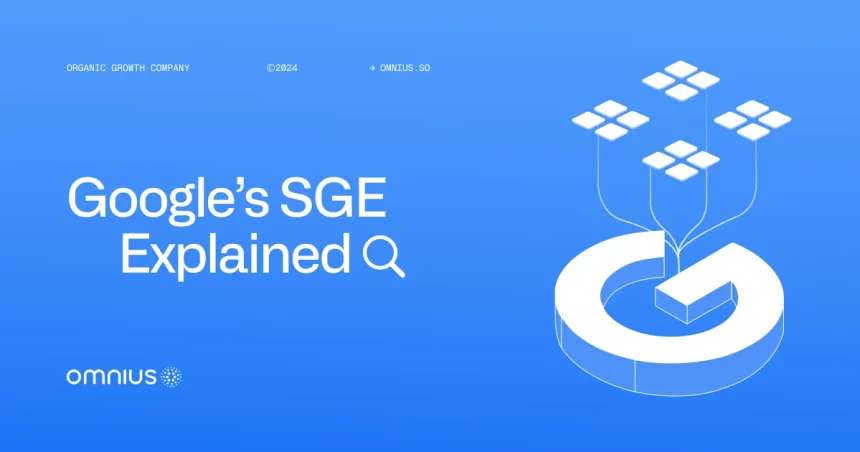Google’s Search Generative Experience (SGE) is transforming how we interact with search engines.
According to their statement, Google is currently testing AI Overviews in the Google search results for a small percentage of US search traffic users.

This blog post dives into insights from recent Google SGE reviews, offering takeaways to help you prepare your digital strategy and:
- Learn about the key features of Google SGE.
- Discover how SGE impacts search results.
- Understand user feedback and industry reactions.
- Find out how to leverage SGE for your business.
Understanding Google SGE: A Brief Overview
Google’s Search Generative Experience (SGE) aims to make searching more intuitive and efficient.
Unlike traditional search, SGE uses advanced AI to generate answers, summaries, and even conversational responses.
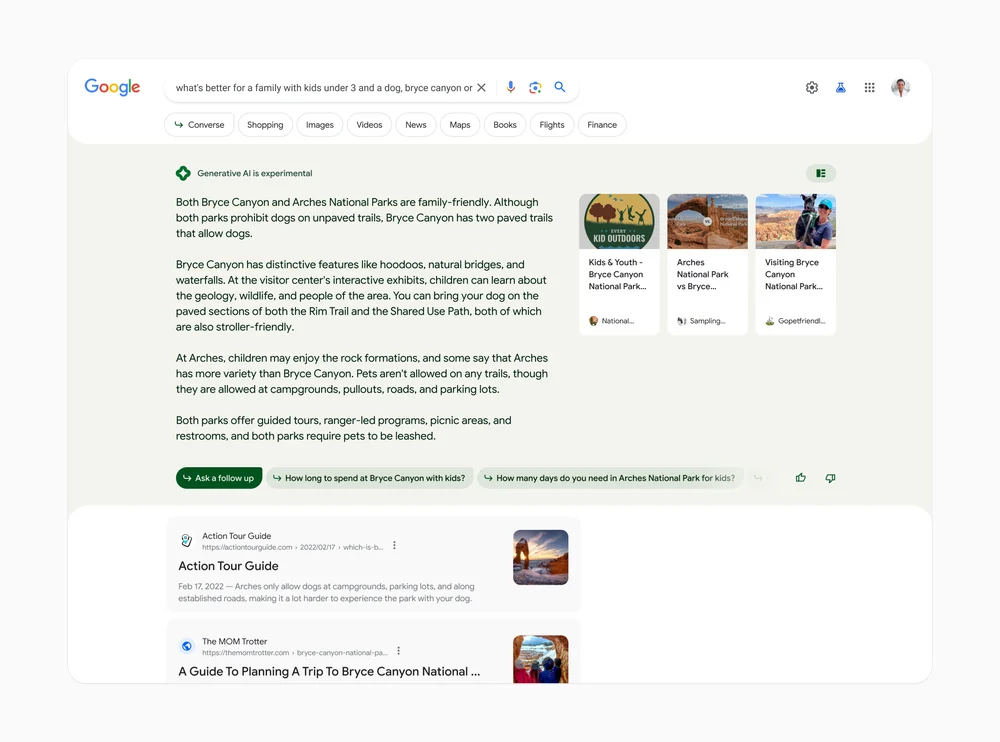
This means users get more detailed information without clicking through multiple links.
With generative AI in Search, people can:
- Ask different types of complex questions that are more detailed and descriptive.
- Get a list of topics immediately, provided with links to explore the relevant results deeper.
- Start with their activities quickly, such as writing drafts or generating content right from the search.
- Ask for conversational follow-ups on specific topics to gain knowledge about specific topics and make progress easier.
What’s great is that SGE is integrated with existing Google services, enhancing the user experience.
For instance, it can pull data from Google Maps, YouTube, Google Lens, and other platforms to provide comprehensive answers.
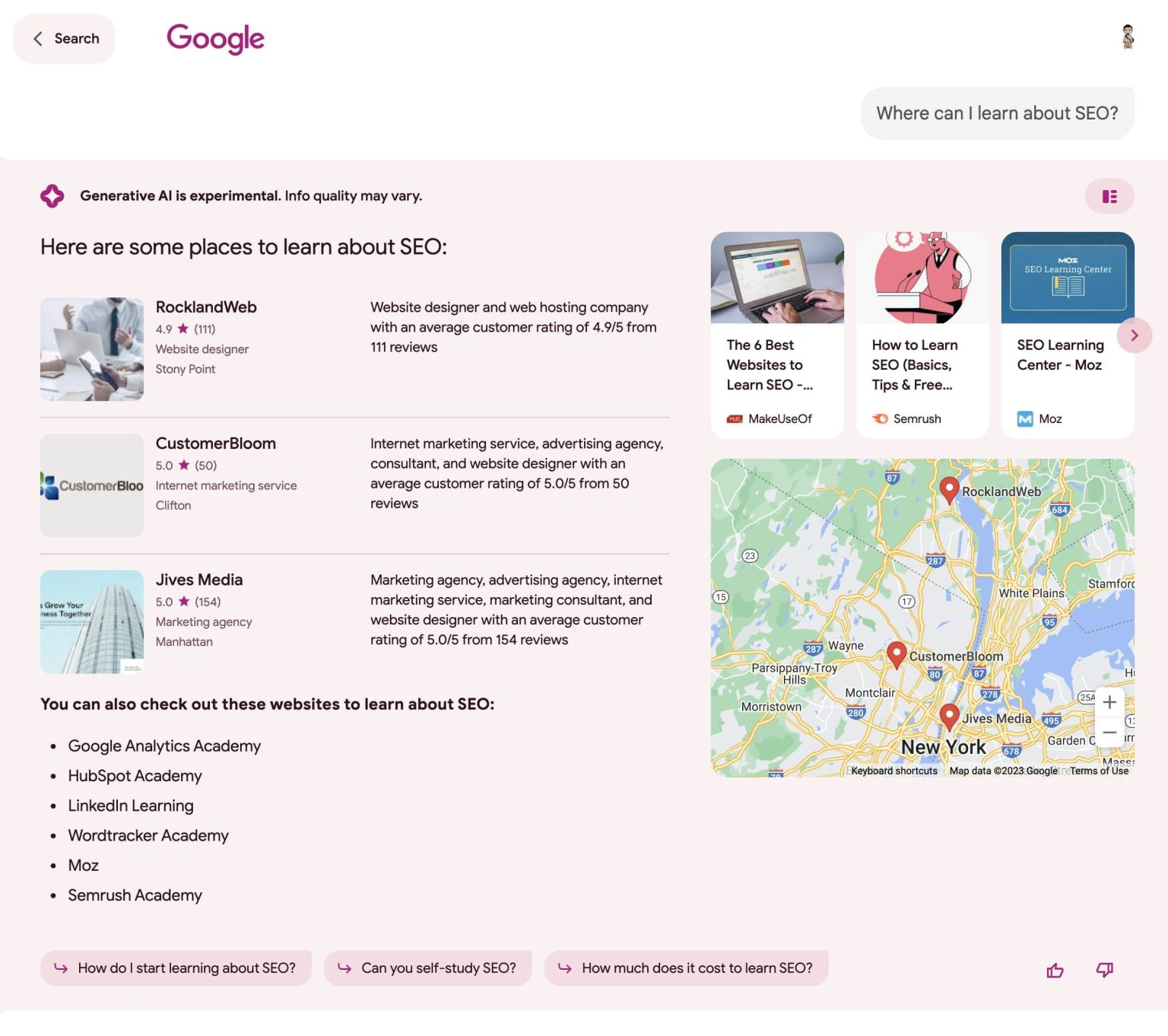
This integration will probably be a powerful tool for businesses looking to improve their online presence, but it will take some time for SEOs to learn how to use its full potential.
But first, let’s review the most important insights related to SGE to help you better understand it.
We’ll also share our assumptions on how it will affect the SaaS and Fintech industries, as well as how to adapt your website for better visibility in the future.
Note: These suggestions are currently based on our early experiments, and this article will be updated as each experiment is confirmed.
Insight 1: How Often do SGE Responses Appear in Search Results?
According to SERanking’s SGE Snippet research, SGE responses are frequently shown in Google search results.
However, there was a decrease from 90% to 64% in SGE snippets presence within SERPs for over 100,000 analyzed keywords within 20 tested niches.
The graph below displays the percentage of keywords that:
- Included SGE snippet,
- Had the “Generate” button,
- Didn’t have an SGE snippet,
- Or ended with an error,

Depending on the niche, the SGE snippets varied.
These are the top 5 niches whose keywords produced the most SGE snippets containing text:
- Food and beverages(33.2%),
- Business (27.2%),
- Relationships (25.9%),
- Ecommerce and Retail (25.7%),
- Fashion and Beauty (25.2%).
Finance came as niche one of the bottom niches that generated fewer SGE snippets, with 11.84% of keywords containing them.
Based on this, we can conclude that Generative AI snippets vary depending on the type of search query, and there are parallels we can draw when compared to traditional SERP features:
- Informational search queries trigger snapshots similar to featured snippets.
- Local search results display a response formatted similarly to a local pack.
- Ecommerce keywords showcase various products in SERP, resembling product carousels.
It’s also important to mention that, according to this research, the more words your query has, the more often it will trigger an SGE snippet.

Given that most of the traffic comes to the website through long-tail keywords, the question is: How will the SGE impact organic traffic?
Insight 2: Google SGE’s Influence on Organic Traffic
To put it more precisely, the real question is: how will AI Overviews impact the traffic of cited and non-cited websites?
With SGE providing direct answers, users may not need to click through to websites as often.
This could lead to a decrease in organic traffic for some businesses.
According to Kevin Indig’s test, AIO citations sent fewer clicks to cited URLs, and the testing domain received -8.9% fewer clicks when cited in AIOs.
Also, some URLs indicated that there might be a chance that some AIOs could generate more traffic to specific pages depending on whether users wanted more information.
But sometimes, AI Overview showed up without a site being cited, which generated organic traffic loss.
However, it’s not all bad news.
When SGE includes snippets from your content, it boosts visibility and credibility.
This can increase brand awareness and attract more clicks to your website.
What can you try doing about it?
According to the explanations above, only having high-quality content that includes detailed information, relevant keywords, and a clear structure might not always be enough.
Keeping your content updated to reflect the latest trends and data is also essential.
Engaging visuals and interactive elements can enhance user experience and improve your chances of being featured in SGE snippets.
Remember, you should become the focus of the conversation between the user and the machine.
Here’s what you can do about it:
- Provide helpful information about the topic and offer advice that reduces users’ time and effort spent on research.
- Identify the providers who can solve the users’ problems.
- Help the user identify the solution that is adapted to their needs and that they are comfortable with.
As an SEO, your job is to influence the algorithms to act in your favor and guide their users to you rather than your competitors.
To make the most of this, ensure your content is well-structured and provides clear, concise, and relevant answers.
Imagine you need to optimize your article “how to use youtube for business” for AI Overview.
To improve your chances of appearing in the AI Overview, cover your topic in detail from your perspective and answer each step clearly and concisely.
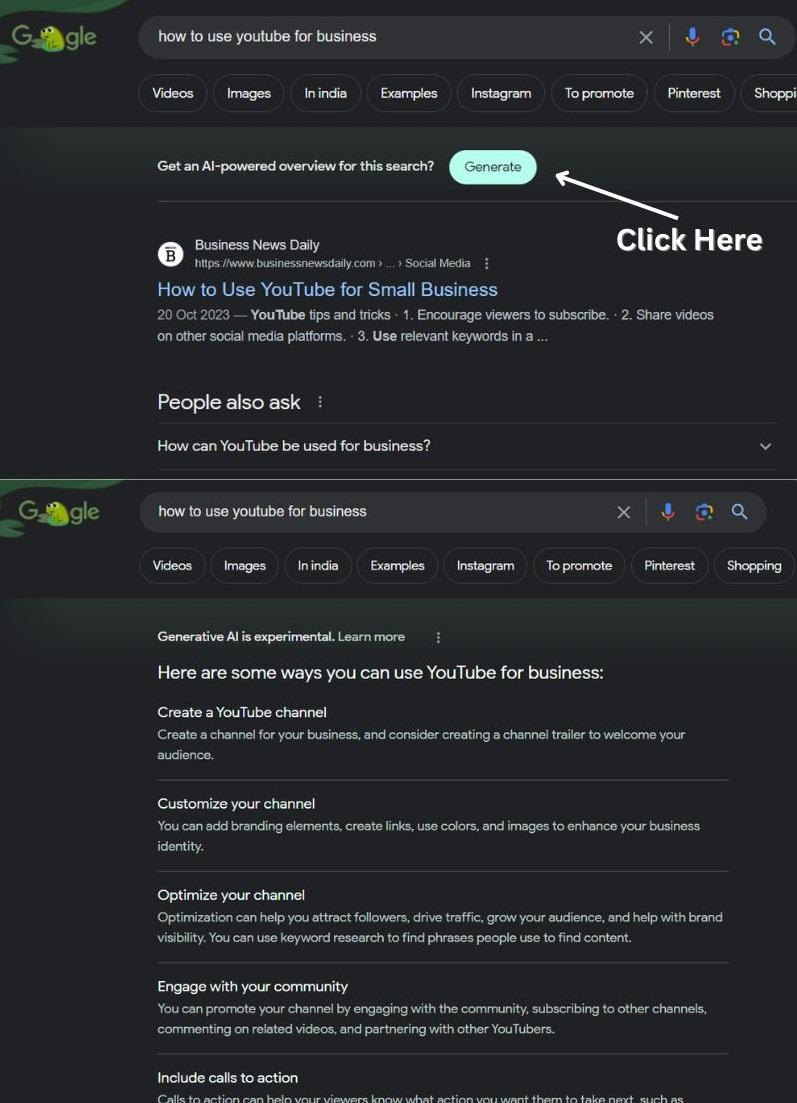
The better you manage to do this, the more benefits it will probably bring to you in the future.
For more info on improving content quality, visit our Content Marketing guide.
Insight 3: Google SGE Connection With Content Quality and Cites
Content quality will be more crucial than ever with Google SGE.
According to Google, since SGE aims to provide the best possible answers, it prioritizes accurate, well-researched, and engaging content.
This means businesses must invest in creating high-quality content to stay competitive.
Your first thought is probably that SGE uses best-ranking search results to generate AI snapshots, similar to how Google used to display featured snippets within SERP.
However, according to SERanking’s testing, this is not always the case.
Their testing showed that SGE snippets displayed around 8 links to different websites.
However, in 2023, only 45% of those snippets were linked to the top 10 organic search results, and now 85.5% of SGE snippets are coming from at least one domain from the top 10 results.

What about the rest of the content that doesn’t come from top results?
As Lily Ray noted, Google also pulls the AI responses from smaller players, including those not ranking high or even providing responses from questionable websites.

This can be a good opportunity for small players to earn a share by creating quality content for users and SGE.
However, it will be much harder for us to distinguish the traffic that came through standard results from the one that came through AI Overviews.
According to Sema Budaraju, Director of Product: “Google will begin reporting AI Overview impressions and clicks in its Search Console reporting, but won’t distinguish those generated by traditional search and AI Overview. Google will lump them all together.“
The future of organic visibility tracking will be combining GSC data with 3rd party tools that will help us measure the AI Overview appearances.
Insight 4: The Role of Google SGE in Lead Generation
Google SGE will probably be a powerful tool for lead generation if you learn to use it properly.
By providing detailed answers and integrating with other Google services, SGE can guide users seamlessly from search to action.
For instance, if your content appears in an SGE snippet, users are more likely to trust your brand and follow through with a call to action.
Additionally, SGE’s ability to pull relevant information from various sources means your business can appear in multiple contexts.
This increases the chances of capturing leads at different stages of the buyer’s journey.
What can you try doing about it?
To optimize for this, focus on creating high-quality, informative content that addresses common questions in your industry.
Regarding the SaaS and Fintech industries, search queries best covered with listicle articles will trigger different snippet types featuring a list of suggested solutions and short descriptions.
Here’s an example when I search for “rank tracking tools:”
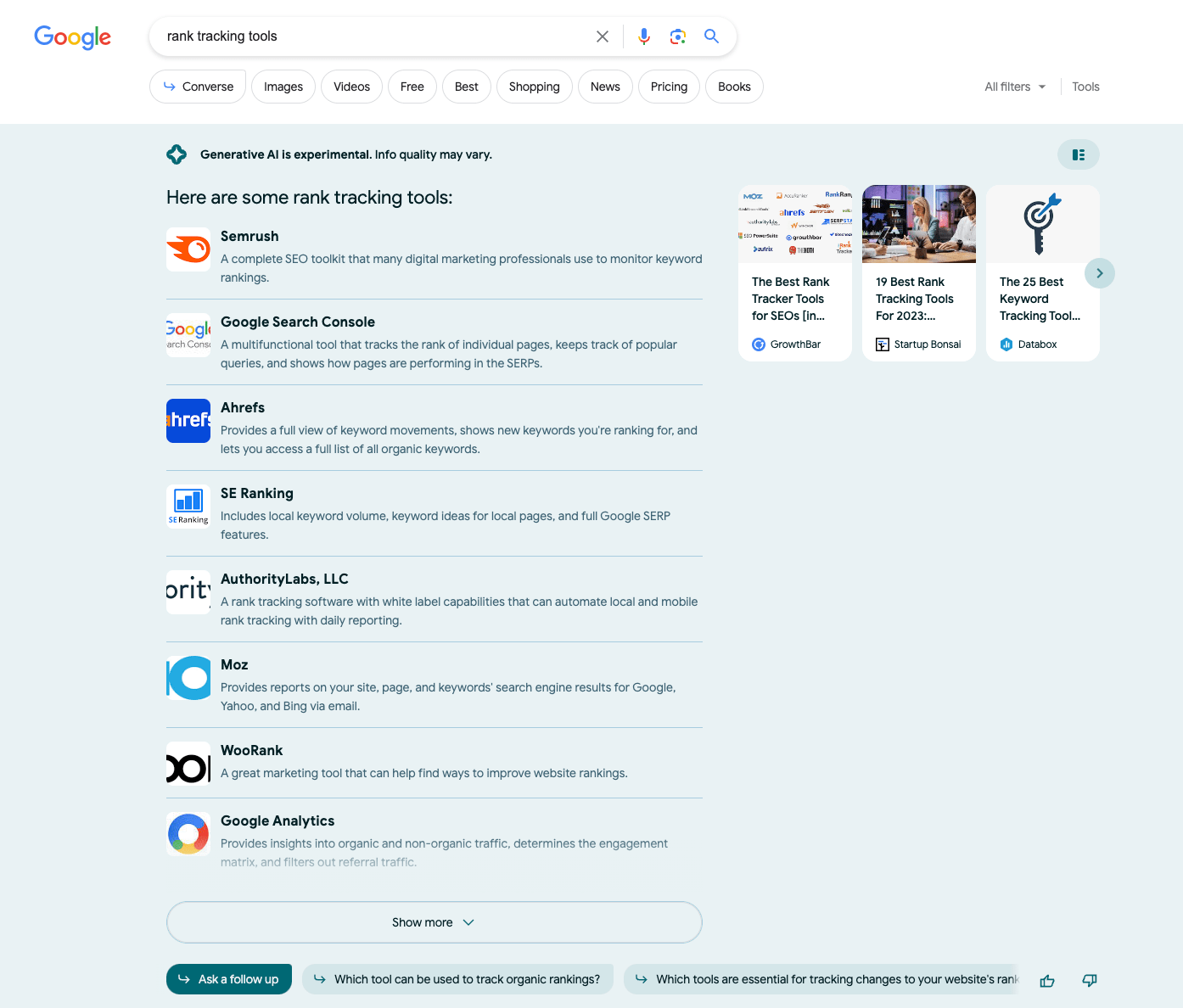
What does it mean for your solution, and what can you do to appear here?
Covering the topics that target high-intent keywords and creating the best listicle articles online will help you improve your chances of your solution appearing in the generative AI answer.
But it doesn’t stop there.
Your solution should also be present on other websites’ listicles, as only appearing as a solution within your own articles probably won’t help you much.
You need to appear in different online sources. How?
Start with backlink outreach activities and ask webmasters to include you in their listicle articles as a solution.
The more relevant websites and the more helpful articles you get mentioned in, the more likely you will appear in the AI overview section as one of the solutions.
I believe that it will work somehow as the current snippets function when it comes to solution lists:
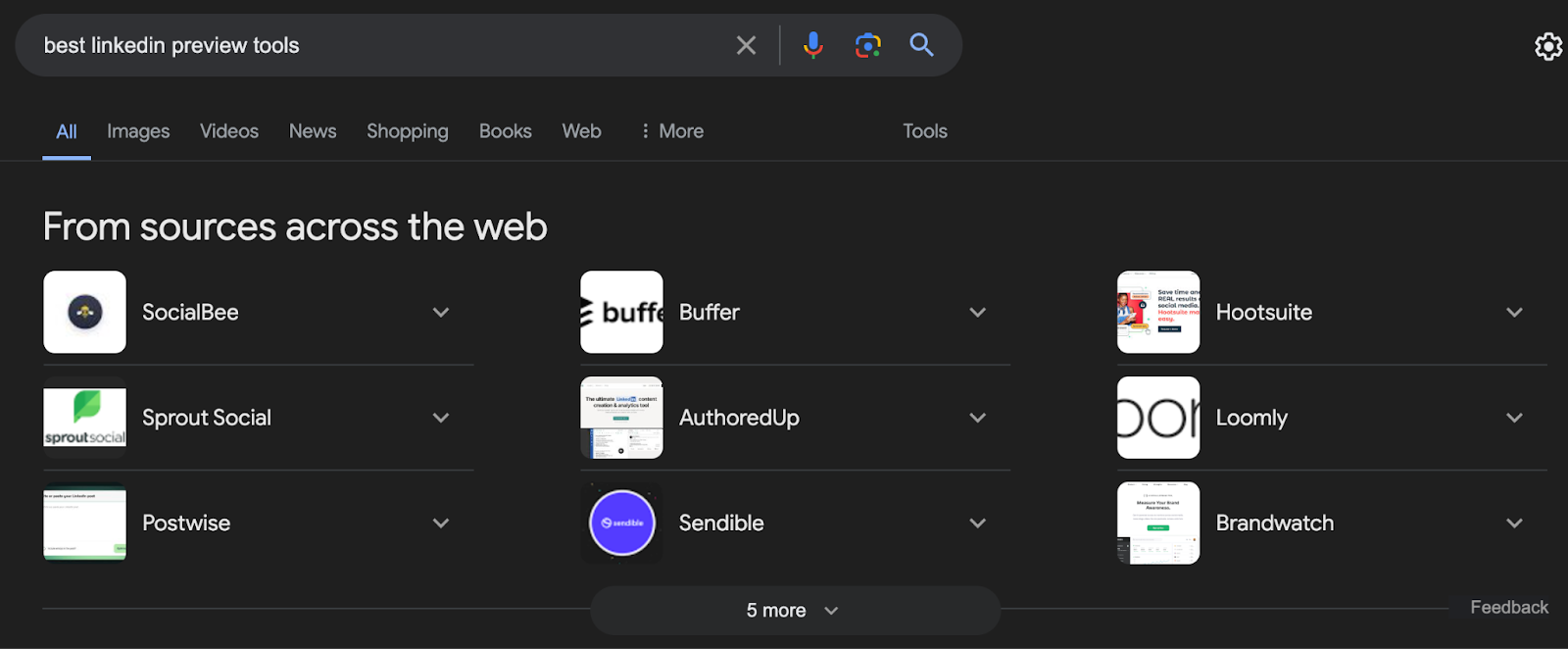
Insight 5: The Cost-Benefit Analysis of Google SGE
Evaluating the cost-benefit of integrating Google SGE into your strategy is essential.
On the cost side, businesses may need to invest more in high-quality content creation and SEO optimization.
This could mean hiring experts or dedicating more resources to content marketing efforts.
Discover how we grew the SaaS tool from 0 to 2.73M Organic Clicks In 13 months and how you can do it, too.
However, the benefits can be substantial.
Enhanced visibility through SGE snippets(the ones we’ve shown for the rank tracking tools) can increase brand recognition and trust.
Additionally, providing instant answers can improve user satisfaction and potentially lead to higher conversion rates.
By weighing these factors, businesses can determine if the investment in optimizing for Google SGE aligns with their goals and resources.
Insight 6: The Future of Google SGE
The future of Google SGE looks promising and dynamic.
As AI technology continues to advance, SGE will likely become even more sophisticated, offering richer and more interactive search experiences.
This evolution means businesses must stay agile and continuously adapt their SEO strategies.
Expect SGE to incorporate more personalized search results, leveraging user data to deliver highly relevant information.
This personalization can enhance user engagement but also requires businesses to focus on creating content that resonates with specific audience segments.
What will happen with SERP features, such as featured snippets?
Currently, various SERP features, including featured snippets, are still present within the SERP.
What’s interesting is that featured snippets appeared directly below the AI snippets, which seems quite counterintuitive since both features serve as quick topic summaries.
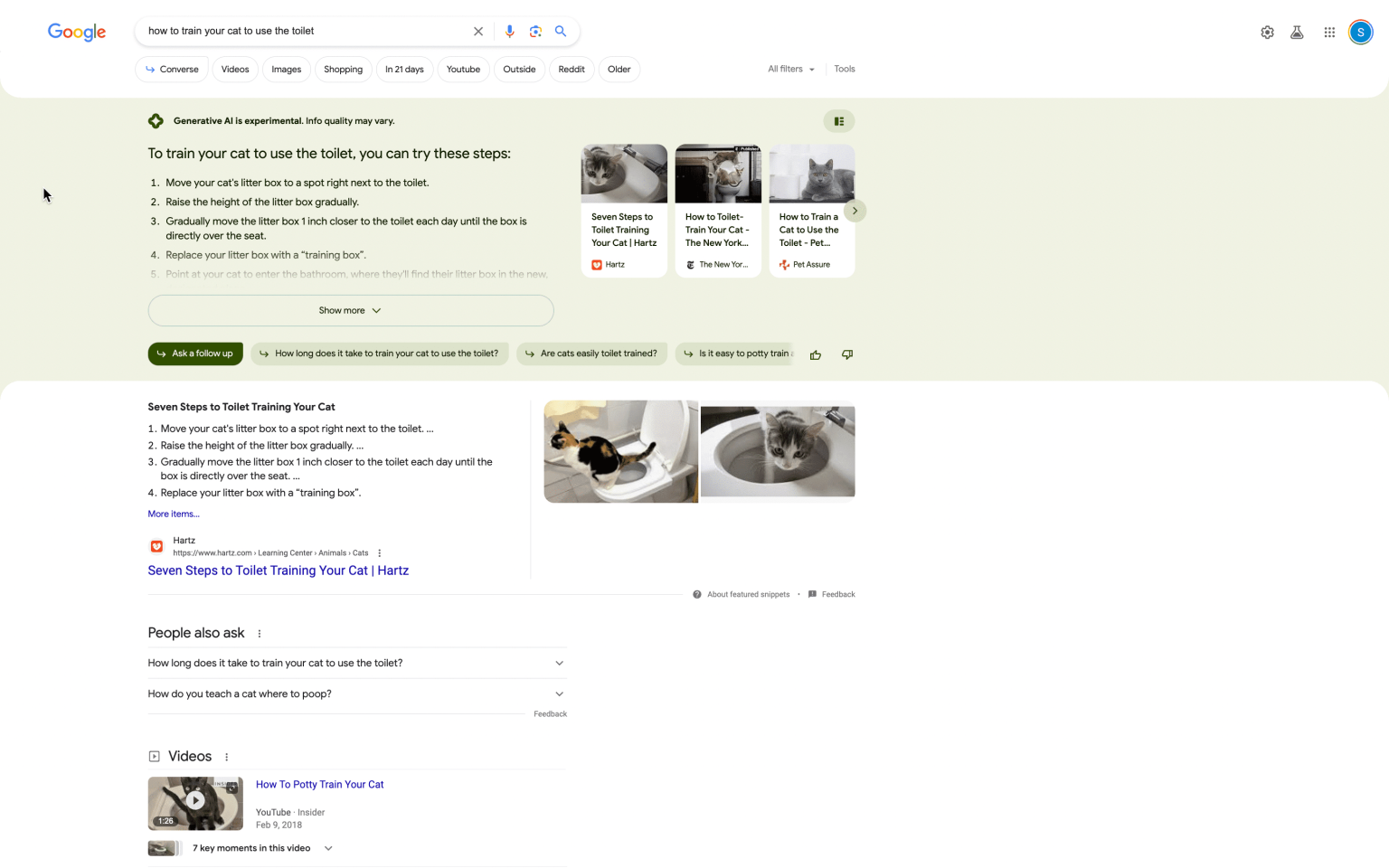
SEOs mostly believe that Google will eventually remove these SERP features (featured snippets, local packs, etc) due to duplicating the information in the AI snippet.
Moreover, the integration of emerging technologies like augmented reality (AR) and voice search could further transform users’ interactions with search engines and look of these sections.
To stay ahead, you should watch industry trends and adapt your content strategy accordingly.
Insight 7: The Limitations of Google SGE
While Google SGE offers many advantages, it also has its limitations.
1. Organic traffic decrease
One notable drawback is the potential decrease in organic traffic, as users may find answers directly on the search page without visiting websites.
This can impact businesses that rely heavily on web traffic for revenue.
2. Smaller companies can be at a disadvantage
Another limitation is the dependency on high-quality content.
Not all businesses have the resources to consistently produce top-tier content, which could put smaller companies at a disadvantage.
3. Inaccurate information
Additionally, SGE’s reliance on AI means that it might occasionally generate inaccurate or biased information.
For example, it may recommended you boil the eggs for up to 60 minutes in total(Don’t listen to it, trust me):
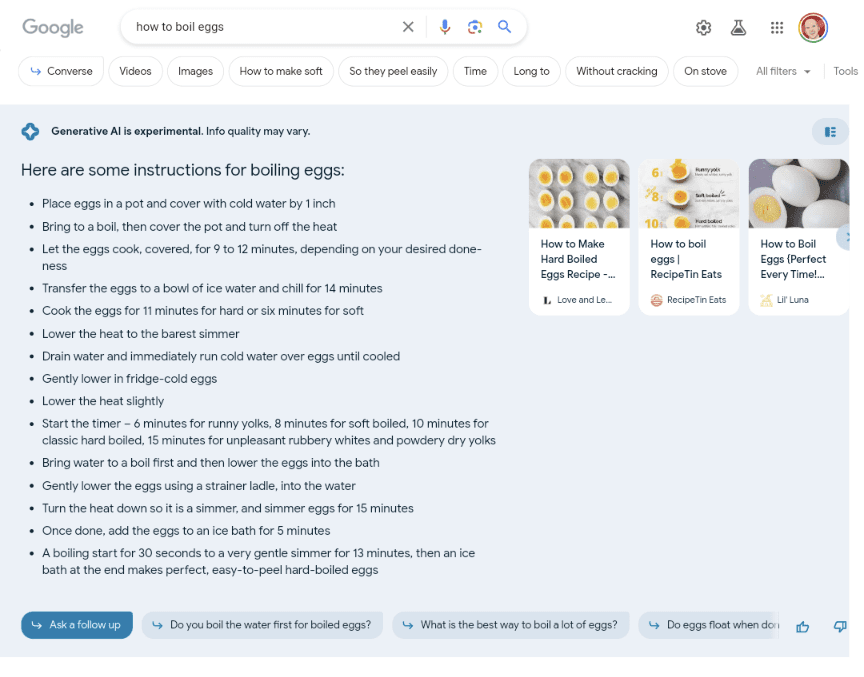
4. Irrelevant source attribution
SGE doesn’t always clearly attribute each piece of information to its relevant and original source.
Here’s the case of Brodie Clark showing it:
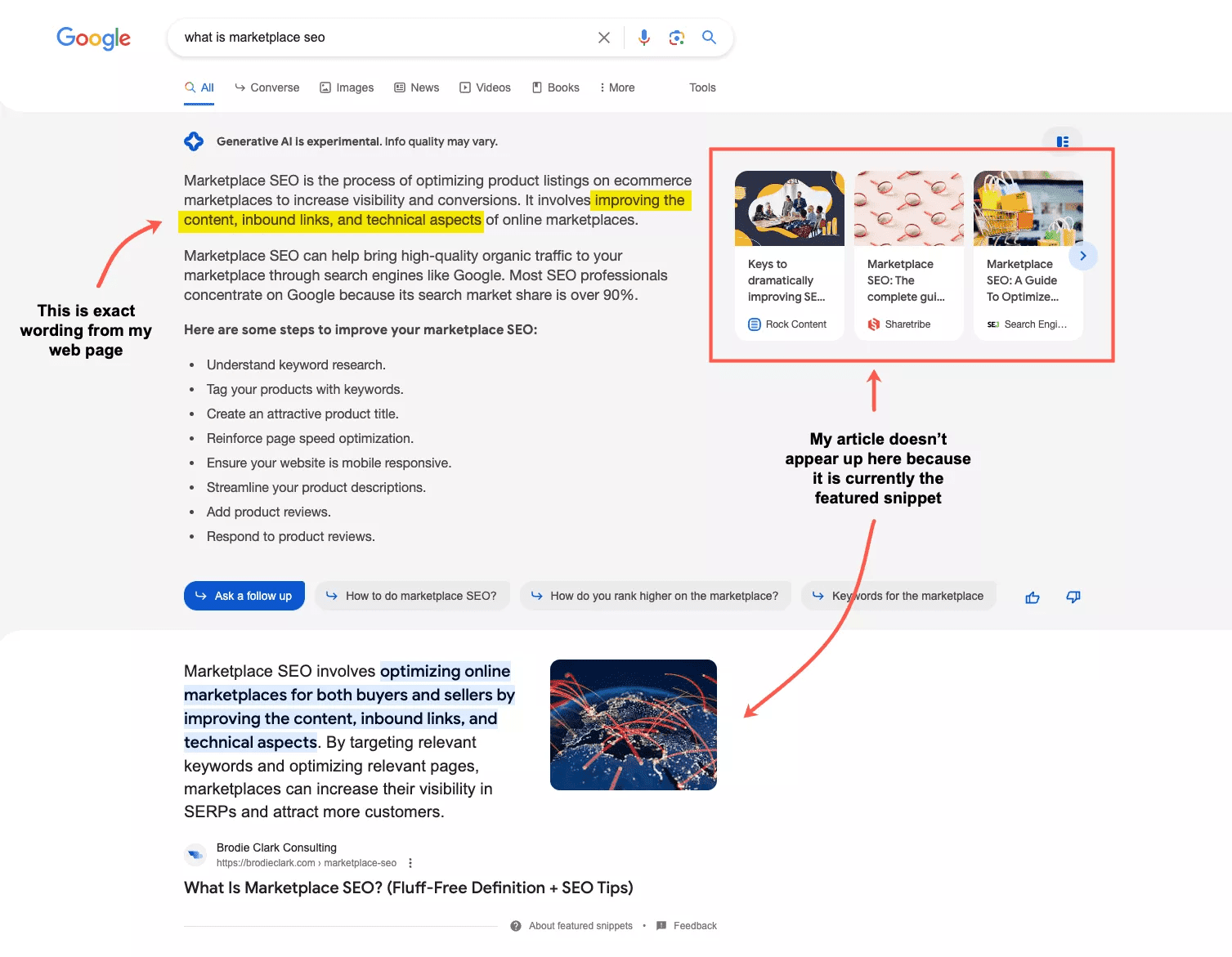
It can also fail to include the quoted article within the link carousel.
Understanding these limitations can help you plan better and mitigate potential downsides.
The Impact of Google SGE on SEO Ranking
Google SGE will significantly change the game for SEO ranking.
Traditional SEO tactics still matter, but SGE introduces new factors to consider.
For example, content quality and relevance become even more critical as SGE prioritizes generating accurate and valuable responses.
Another key impact is on keyword research strategy.
Instead of focusing solely on exact matches, SGE favors content that answers questions comprehensively.
Here’s an example of how frequently keywords with different search volumes trigger AI overviews according to SERanking research:
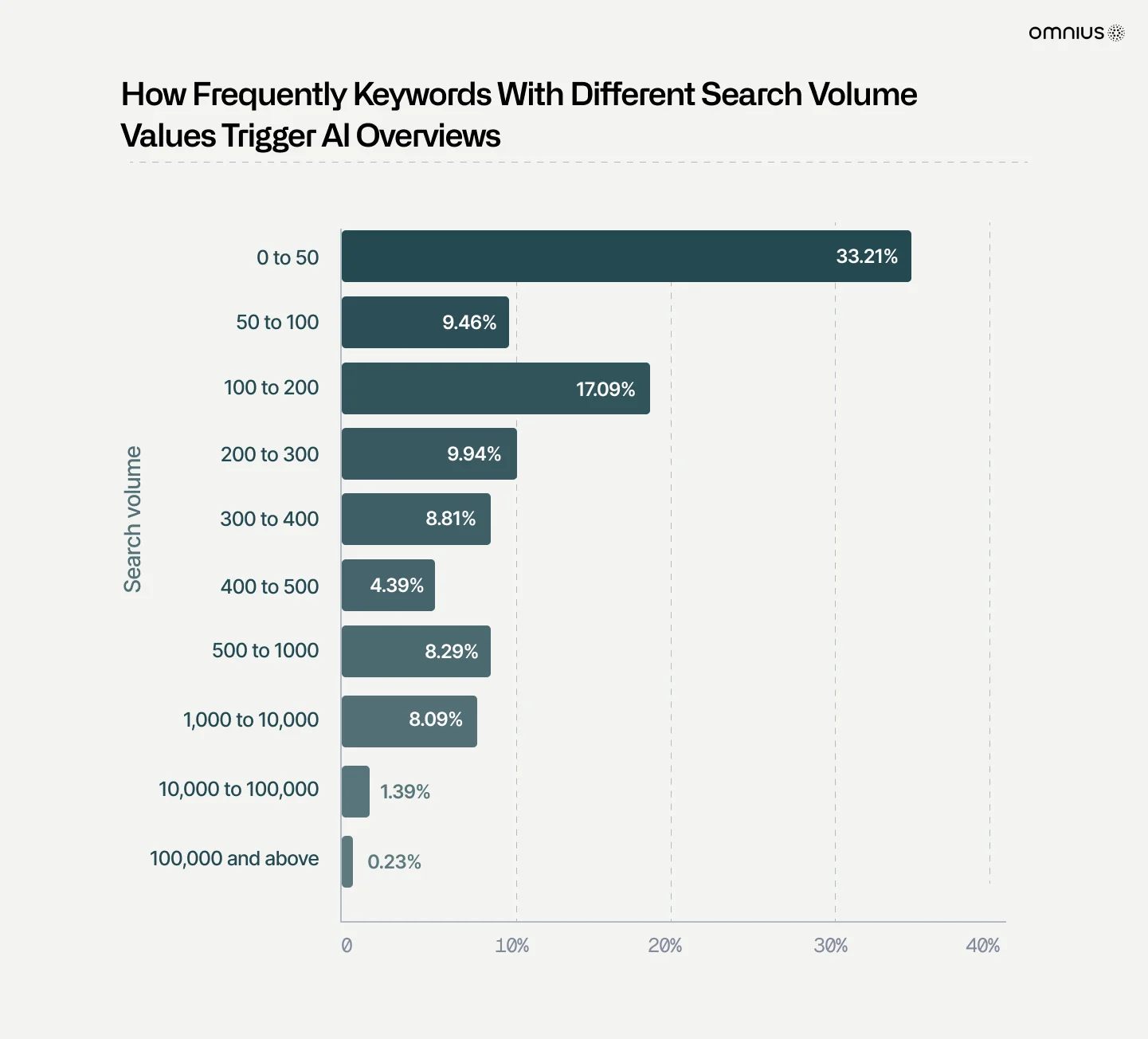
So, long-tail keywords and natural language queries will be more likely to rank within AIOs.
This is logical as very specific long-tail keywords with a higher probability of triggering AIO snippets usually have low search volumes(50 monthly searches or below).
Moreover, user engagement metrics like click-through rates (CTR) and time spent on a page will become even more important.
Wrapping Up: Understanding and Preparing for Google SGE
Like every other time, the most we’ll need to focus on is measure, test, learn and adapt.
AIOs will lead to a lot more longtail keywords(as confirmed by Sundar Pichai) and voice searches.
To make the most of Google SGE, you must focus on several key areas to stay on top of Google’s AI models.
First, prioritize creating high-quality, relevant content that answers users’ questions comprehensively.
This will help you increase the chances of your content getting featured in SGE snippets and improve visibility.
Next, adapt your SEO strategy to include long-tail keywords and natural language queries.
This aligns with SGE’s preference for detailed, conversational responses.
Additionally, monitor user engagement metrics like click-through rates and time spent on the page to ensure your content remains engaging.
Finally, stay updated on industry trends and be ready to adapt as SGE evolves.
By continuously refining your approach, you can leverage SGE to enhance your online presence and attract more qualified leads.
Need help?
Contact us and schedule a free consultation to learn how creating high-quality content will help you stay ahead of your competitors and become a top favorite of AI Overviews.
FAQ:
What does Google SGE do?
Google SGE, or Search Generative Experience, enhances the search process by using advanced AI to generate detailed answers and summaries.
It integrates various Google services to provide comprehensive responses, making it easier for users to find the information they need without clicking through multiple links.
How to prepare for Google SGE?
To prepare for Google SGE, focus on creating high-quality, informative content that answers common questions in your industry.
Incorporate long-tail keywords and natural language queries into your SEO strategy.
Ensure your content is well-structured and up-to-date.
Engaging visuals and interactive elements can also enhance user experience.
What does SGE mean?
SGE stands for Search Generative Experience.
It’s Google’s initiative to make search more intuitive by generating detailed answers and integrating data from various sources.
This approach aims to provide users with more accurate and comprehensive information quickly.
Nguồn: omnius.so




